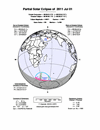- - text and links as of last publication - -
![]()
| CAUTION! OBSERVING A SUN ECLIPSE IS DANGEROUS AND MAY CAUSE IRREVERSIBLE EYE DAMAGE, UP TO BLINDNESS, ANNULAR AND PARTIAL ECLIPSES INCLUDED! Observing a Sun eclipse necessitates DEDICATED SAFE TECHNIQUES! |
Here is the 3rd solar eclipse of that year, and still a partial one! It occurs one lunation after the previous one, last June 1st. As it occurs in the desolated far reaches of the Antarctic Ocean, South of South Africa. As Fred Espenak states, it might well turn like the solar eclipse that nobody sees. A partial solar eclipse occurs when neither the 'umbra' nor the 'antumbra' of the eclipse touches Earth in any place as the 'penumbra' does, only. Anywhere in the area of a partial solar eclipse, observers are treated with a Sun indented by the dark disk of the Moon. for more about the solar eclipses, theoretically, see our tutorial "Sun Eclipses"
Eclipse's greatest is occurring by 08:38:23 UT as is concerns a D-shaped about the size of India. The Prince Edwards Islands, which belong to South Africa might be inside the area of the eclipse as the Crozet Islands (France) might be close to there as the eclipse magnitude is reaching a mere 9,71 percent at its maximum
Eclipse's main data are the following (data as of November 2010, F. Espenak, NASA/GSFC). The Moon's apparent diameter will be of 31' 17.2", compared to the Sun's 31' 27.8". for more about how to observe a solar eclipse, see our tutorial "Observing a Sun Eclipse ":
- greatest eclipse: 08:38:22.7 UT
- eclipse magnitude (fraction of the Sun's diameter obscured by the Moon at greatest eclipse): 0.0971
- P1 to P4 (moments of first-last external-internal tangency of the penumbra with Earth's limb; practically these are the moments of the eclipse for the places where the eclipse is partial); in UT: P1 at 07:53:41.6, P2 at 09:22:47.6 (no P2 nor P3 times as the cone of the penumbra is not entirely contained upon Earth's disk)
 | see a map for the July 1st, 2011 Partial Solar Eclipse. map courtesy Fred Espenak - NASA/GSFC |
. for more about this eclipse and for more about solar and lunar eclipses generally, you may see at Fred Espenak's NASA's eclipse website
Observation Reports: no special report was made about that eclipse
Website Manager: G. Guichard, site 'Amateur Astronomy,' http://stars5.6te.net. Page Editor: G. Guichard. last edited: 1/1/2011. contact us at ggwebsites@outlook.com